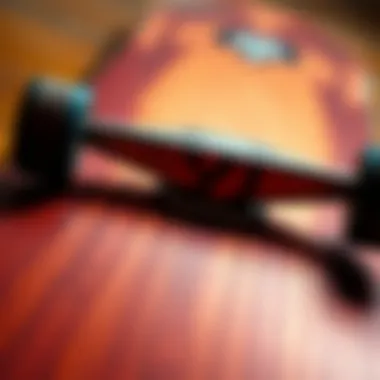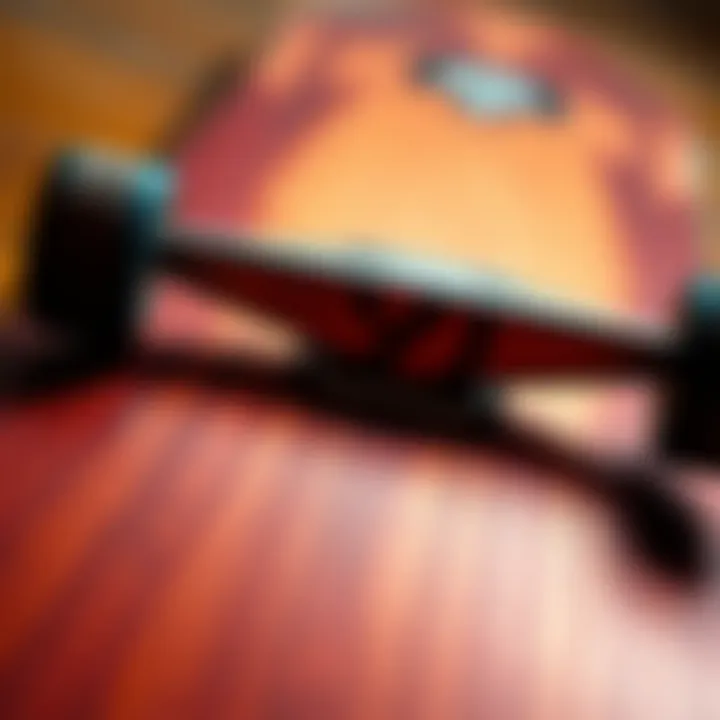In-Depth Guide to Size 9 Skateboard Decks


Intro
In the world of skateboarding, the choice of a skateboard deck can be a game changer. Among the various sizes available, size 9 skateboard decks have carved a niche. They offer a unique blend of stability and maneuverability, making them a choice for a broad range of riding preferences. Whether you’re just starting out or have been shredding the pavement for years, understanding the nuances of size 9 decks is vital.
This exploration will dive deep into what makes these decks stand out. From the anatomy of a deck to how it influences performance during tricks, every aspect plays a role in shaping a skater's experience. By examining the materials, dimensions, and design intricacies, readers will be better equipped to make informed choices about their skateboard gear. Let’s kick off this journey by discussing some essential skateboarding techniques.
Understanding Skateboard Deck Sizes
Skateboard deck sizes play a pivotal role in the performance and experience of every skater. Choosing the right size impacts not just how a skateboard feels underfoot but also influences trick execution, control, and stability on various terrains. A comprehensive understanding of skateboard deck sizes is crucial for both novice and seasoned skaters alike.
Every skater must consider their individual style and preference, and understanding the nuances of deck sizes ensures that they can make informed decisions. Beyond just feeling comfortable with the board, the right size can drastically affect one’s ability to land tricks or skate in different environments.
General Size Guidelines
Skateboard decks generally range from sizes 7.5 inches to 9.5 inches in width. Size 9 decks, for instance, are often favored for their balanced feel, making them suitable for a variety of skating styles.
Here’s a quick breakdown of general size guidelines for skateboard decks:
- Narrow decks (7.5" to 8.0"): Typically preferred by street skaters and those engaged in technical tricks.
- Medium decks (8.0" to 8.5"): A versatile choice that fits many styles, appealing to skaters looking for a mix of stability and maneuverability.
- Wide decks (8.5" to 9.5"): Ideal for bigger skaters or those who prefer a stable platform for cruising, pool riding, or those who want extra space for tricks.
By sticking to these guidelines, skaters can better align their deck choice with their personal skating style.
Comparative Analysis of Deck Sizes
Size variations
The world of skateboard decks isn't one-size-fits-all. Size variations exist to cater to various preferences and skating styles. A size 9 deck, for instance, offers a wider platform which provides enhanced stability. This characteristic makes it a popular choice among skaters who appreciate both tricks and cruising. The wider stance allows for easier landings, particularly when attempting more complex maneuvers. That said, the larger size can be unwieldy for those who lean towards technical skating, where every inch counts.
Performance differences
Different widths can lead to performance differences that skaters can't afford to overlook. The performance of a size 9 deck tends to favor stability and balance. This deck size makes it easier to roll over obstacles and maintain control at higher speeds. Skaters often find that wider decks help reduce foot fatigue, allowing for longer sessions without aches or discomfort. However, this added stability comes at the cost of the agility that narrower boards provide, which can be a downside for those who prioritize technical tricks.
Rider preferences
Rider preferences are a crucial factor in understanding skateboard deck sizes. Many skaters gravitate towards a size 9 board for its versatility and comfort. This board can cater to a broader audience, from beginner skaters testing their footing to experienced riders looking for a reliable option for different skating environments. However, it’s important to remember that personal style plays a hefty role. Some might feel more in tune with a narrower deck for street skating, while others may relish the width for cruising or transition.
The choice of the right board size is uniquely personal, and understanding these variables makes all the difference.
"Choosing the right skateboard deck size is all about aligning it with your body type and skating style to ensure an optimal riding experience."
Comprehending the various dimensions and how they relate to performance can significantly enhance a skater's skill set and enjoyment of the sport.
The Dimensions of a Size Deck
In the world of skateboarding, the dimensions of a skateboard deck play a significant role in defining the rider's experience and performance. A size 9 skateboard deck, specifically, brings a balance between surface area and maneuverability. Understanding its dimensions is essential, as it can impact everything from trick execution to stability during rides. In this section, we will explore the critical attributes of a size 9 deck's dimensions—including its width, length, and overall shape—and how these factors cater to diverse skating styles.
Width and Length Specifications
When discussing a size 9 skateboard deck, the most immediate aspect to consider is its width, which typically measures around 9 inches. This particular width strikes a favorable balance: it's wide enough to provide a stable platform for both street tricks and vert transitions, yet not so wide that it becomes cumbersome.
The length of a standard size 9 deck generally hovers around 32 inches, although this can vary slightly depending on the brand and specific design. This length is optimal for maintaining control while performing tricks, giving skaters the leverage they need without feeling overly stretched out.
"A well-sized deck isn't just about looks; it’s about performance, control, and achieving that perfect land."
Here are a few key considerations related to the width and length specifications of a size 9 skateboard deck:
- Stability: The sufficient width helps ensure that the rider has good footing, which enhances balance. Ideal for those who may be still tackling their first ollies or perfecting their kickflips.
- Versatility: This size tends to appeal to a wider range of riders, from beginners to seasoned skaters, as it caters to various styles.
- Comfort: Skaters often find that a size 9 deck allows for natural foot placement, particularly for taller individuals who may require a larger platform.
- Trick Execution: It offers enough room for flips and tricks while still allowing for quick, agile movements. This aspect is especially crucial in street skating, where instant responsiveness can dictate the success of a trick.
The Role of Nose and Tail Shape
A skateboard deck’s nose and tail shape can greatly influence a rider's overall experience. On a size 9 deck, you generally find a medium concave combined with a responsive kick tail and a well-defined nose, ensuring that skaters can execute tricks with precision.
- Nose Shape: The front of a size 9 deck often features a slightly wider nose, which provides additional space for performing tricks like the frontside ollie. This added surface area makes it easier for skaters to catch their board when landing from jumps.
- Tail Shape: Similarly, a well-defined tail ensures that riders can pull off powerful tricks such as pop shuvits and varial flips. The curvature and angle of the tail contribute to the overall pop of the board, affecting how high and confidently a skater can launch.
- Personal Preference: While generalizations exist, some riders might lean toward a more pronounced kick on the tail for better jumping ability, while others may prefer subtle curves for a smoother ride.
Understanding these nuances points directly to why a size 9 skateboard deck stands out in a crowded market. Each element—width, length, nose, and tail shape—intertwines to craft an experience that balances stability with the flexibility needed to express one’s skating style.
Material Types for Skateboard Decks
Choosing the right type of material for skateboard decks is fundamental in determining overall performance and durability. The materials used in constructing skateboards not only affect how a deck feels underfoot but also dictate how it responds during tricks, transitions, and everyday rides. This section breaks down the common materials used for size 9 decks which specifically cater to both street and park skaters. Understanding these materials helps riders make informed choices, contributing to their overall skating experience.
Common Materials Used
Maple
Maple is often considered the gold standard in skateboard construction, particularly for size 9 decks. It's extremely durable, providing a balance between rigidity and flexibility. The unique characteristic of maple is its layers—most decks are made of 7-ply maple, which means seven thin sheets are glued together to form a solid, yet lightweight, board. This multilayer construction enhances the deck's strength significantly.
The benefits of maple are plentiful. For one, it offers excellent shock resistance, making it ideal for absorbing the impact from hard landings. That allows riders to focus more on their tricks and less on the fear of breakage. Also, it tends to hold its shape well over time, maintaining performance even through rough handling. The downside, however, is that pure maple decks might be heavier compared to other materials. This added weight can affect the flick for technical tricks if a skater is not used to it.
Bamboo
An increasingly popular alternative, bamboo decks have emerged as a compelling option for environmentally conscious skaters. The key characteristic of bamboo is its high strength-to-weight ratio, which allows for a thin, lightweight design without sacrificing durability. Bamboo can provide a smooth ride, thanks to its natural flex that absorbs vibrations effectively.
Notably, bamboo boards can be significantly lighter than traditional maple decks, which can give an advantage in certain skating styles, especially in street areas where quick maneuvers are crucial. However, while bamboo is strong, it sometimes lacks the pop that many street skaters seek, making it a less favorable option for those who prioritize tricks that require solid vertical lifts.
Fiberglass
Fiberglass is often used as a reinforcement layer over traditional woods like maple or bamboo. A main advantage of fiberglass itself is that it can enhance the board's rigidity while keeping it lightweight. Moreover, it can provide a distinct responsiveness, making it well-suited for those looking for precise control and stability during high-speed rides.
Adding a layer of fiberglass can minimize the risk of delamination, ensuring a longer lifespan for the deck. The downside is that fiberglass is often more expensive, and this price might not align perfectly with every rider's budget. Furthermore, some skaters find that boards with fiberglass can be less forgiving during tricks, needing more technique to master compared to softer materials.
Impact of Material on Performance
The material a skateboard deck is crafted from has far-reaching consequences on its performance. For instance, while maple offers durability and excellent pop, bamboo's lightweight nature can enhance maneuverability. Contrarily, fiberglass might improve board stability but can alter how a rider perceives the surface under them. It’s essential to choose wisely, as the material will largely dictate the sensations experienced when skating, from the feel during landings to how tricks are executed.
"Choosing the right board material is like picking the right tool for a job; it can make all the difference in performance and enjoyment."
Understanding these subtleties can elevate a skater's experience, allowing them to dive deeper into the craft and express themselves more freely on their decks.
Design Features of Size Skateboard Decks
When it comes to skateboarding, the design features of a size 9 skateboard deck are not just about aesthetics; they play a critical role in the overall performance and feel of the ride. A well-thought-out deck design can influence a rider's ability to execute tricks, maneuver through obstacles, and maintain stability while skating. This section will delve into two primary aspects that define the appeal of these decks: graphics and aesthetics, and the variations in concave and kick tail shapes.
Graphics and Aesthetics
First impressions do matter, and when it comes to skateboards, graphics carry a weighty significance. Skateboard graphics serve not only as personal expression but also as a marketing tool that connects enthusiasts with brands. In the skateboarding realm, a unique design can make a deck standout from the rest.


Consider how one might choose a deck with eye-catching art from a popular artist or a local designer. The bold colors, intricate patterns, and even the brand's logo are often a reflection of the skateboarder’s personality and style. It’s more than just a piece of wood; it embodies the skater’s identity.
- Cultural Representation: Many designs connect to subcultures, music genres, or local scenes, enhancing their appeal among specific demographic groups.
- Color Psychology: Bright colors can energize and inspire creativity, while darker colors offer a more subdued, perhaps serious tone.
Additionally, custom graphics can make a significant impact. Some skaters prefer to personalize their decks with stickers or paint, further enhancing their individuality. A personalized deck speaks volumes about the rider's taste and can also foster a sense of belonging within the community.
"A skateboard is like a canvas; the design is your self-expression on wheels."
Concave and Kick Tail Variations
Next, let’s touch on the technical side of things with the variations in concave and kick tail shapes found in size 9 decks. These aspects often go unnoticed by casual observers but are fundamental in shaping a rider’s experience.
Concave Shape: The concave refers to the upward curve of the deck. Here are some common variants:
- Shallow Concave: This type offers a flatter surface, more suitable for stability during cruising and casual rides.
- Medium Concave: This strikes a balance between comfort and performance, making it versatile for various styles, including street and tricks.
- Steep Concave: Ideal for technical tricks, it provides a greater grip underfoot, allowing for better flip tricks and flip variations.
Kick Tail: This is the upward slant at the back end of the board and can significantly affect the execution of tricks. Here’s how different tails can alter performance:
- High Kick Tail: Offers enhanced leverage for trick execution, allowing riders to perform ollies and flips with greater ease.
- Low Kick Tail: Good for stability and better suited for cruising and casual ramps rather than technical tricks.
The choice of concave and kick tail determines how responsive a board is during rides. It can lead to a more intuitive feel beneath one’s feet, making skating an exhilarating experience. After all, having the right configuration can empower a skater to flawlessly land that challenging trick or effortlessly ride the park.
In summary, the design features of size 9 skateboard decks combine aesthetic appeal with functional performance elements, catering to the diverse needs and preferences of skaters. By understanding the nuances of graphics and concave variations, riders can choose a deck that resonates with their style and supports their skating ambitions.
Choosing the Right Deck for Your Skating Style
Choosing the right skateboard deck is crucial for every skater, regardless of skill level. Not only does the size influence how you perform tricks, but it also affects your overall comfort and control while riding. A properly selected size 9 deck can make or break someone's skateboarding experience. Understanding this can deeply enhance your skills and enjoyment.
Street Skating Considerations
Street skating demands a unique approach to deck selection.
Impact on tricks
When it comes to street skating, the impact on tricks is significant. A size 9 deck has a certain width that can enhance the execution of flips and grinds. Ideally, the wider base allows for better foot placement, making it easier to pop the board.
- Key Characteristic: A wider deck can offer more room for tricks, providing less chance of slipping off, which can be a game changer for new and seasoned skaters alike.
- Unique Feature: A size 9 deck promotes better landings due to its stability. This feature is essential for street skaters who often navigate various terrains and unforeseen obstacles.
- Advantages: Better trick consistency and increased confidence when trying new moves. However, it's essential to note that a larger deck might feel bulky for some skaters, affecting maneuverability.
Deck stability
Stability is another cornerstone for street skating. A size 9 deck brings a balance between stability and control, which can be vital during tricks.
- Key Characteristic: The width allows the skater's foot to distribute weight more evenly, improving balance.
- Unique Feature: Many street skaters favor a sturdy deck because it minimizes the risk of breakage during heavy tricks. This consideration of stability complements the increased confidence in trick execution.
- Disadvantages: On the flip side, while a stable deck is beneficial, some might find a trade-off in terms of nimbleness, particularly in cramped urban settings.
Vert and Park Skating Needs
The demands of vert and park skating vary dramatically from street skating. Here, the focus shifts to dynamics that can enhance performance.
Balance vs. control
For vert and park skaters, balance and control dictate how you interact with the skateboard and the ramps.
- Key Characteristic: A size 9 deck gives extra support for higher tricks, especially during grinds and aerial maneuvers.
- Unique Feature: This size allows skaters to find a zen-like balance, enabling them to adjust their stance while in mid-air quite fluidly.
- Advantages: It can make a tremendous difference for those looking to push their limits; however, skaters new to the craft may feel overwhelmed due to the sheer size of the deck during initial learning phases.
Deck height considerations
Height is often overlooked but can drastically affect how a skater performs at ramps or bowls.
- Key Characteristic: A size 9 deck usually syncs well with a higher tail or nose, creating an increased leverage effect for stalls and airs.
- Unique Feature: Higher decks can help skaters achieve more vertical lift, which is a critical factor during competitions where height and air maneuvers are rated highly.
- Disadvantages: But, one must account for how a high deck can feel for ground tricks. It may lead to awkward landings, especially for less experienced skaters who are more accustomed to lower profiles.
In wrapping this section up, the nuances of deck selection are plentiful. Each skater's journey is uniquely their own, filled with personal preferences and preferences for style, ultimately shaping their experience. The right size 9 deck can unlock the potential for exhilarating performance, whether you're grinding the city streets or soaring through the air in a park.
The Importance of Deck Shape
The shape of a skateboard deck might seem like a minor detail, but it plays a pivotal role in shaping a rider's overall skateboarding experience. For size 9 decks, understanding the nuances of deck shape is essential for performance, comfort, and personal style. Here, we will explore how the various shapes affect how a skater interacts with their board, ensuring they can make informed choices that align with their skating preferences.
Symmetrical vs. Asymmetrical Shapes
When comparing symmetrical and asymmetrical skateboard shapes, one may notice a stark contrast in performance and usage.
- Symmetrical Shapes: These decks are identical on both ends, providing flexibility in riding style. Riders can ollie or land any direction without worrying about the orientation of the board. This design is popular among street skaters who often switch between tricks and require an element of unpredictability. A classic example is the typical popsicle shape.
- Asymmetrical Shapes: On the flip side, asymmetrical decks cater to specific skating techniques and styles. These boards often have different nose and tail shapes, offering tailored performance suited to either street or ramp riding. For instance, a deck with a longer tail provides better lift for trick execution, while a sharper nose can improve control for street skating.
Both shapes have their place, so the choice really boils down to what feels best for the individual rider.
Effects of Shape on Technique
The impact of deck shape on skater technique cannot be overstated. Here’s how different shapes can affect performance:
- Landing Stability: A wider, more symmetrical deck provides better stability during landings, crucial for complex tricks where precision is key. Riders often find that an adequate width helps them maintain balance as they impact the ground.
- Pop and Control: Asymmetrical designs, particularly those with a pronounced tail, excel in producing a solid pop. This is vital for tricks like kickflips or heelflips, where the tail must engage effectively with the ground for those eye-catching flips.
- Transition Riding: Riders engaging in vert skating appreciate shapes that enhance control and grip on ramps. An appropriate curve in the deck can help skaters navigate transitions more smoothly.
"Choosing the right deck shape is like finding the perfect shoes for a journey. It can make all the difference in comfort and performance."
For deeper knowledge on deck shapes, enthusiasts can check resources such as Wikipedia, or discussions on platforms like Reddit.
Customization and Personalization
Customization and personalization in skateboard decks have become significant aspects for skaters today. Gone are the days when one-size-fits-all was the order of the day. In this era, skaters seek decks that resonate with their individual style and performance needs. Tailoring a skateboard deck goes beyond aesthetics; it profoundly impacts how skaters connect with their board, enhance their skills, and express themselves.
By offering a variety of features and designs, skateboard manufacturers allow riders to create what truly feels like their own. Riders often find that a personalized deck not only adds flair but also can improve their overall performance on the board. This aspect of customization essentially means leveraging different deck elements to suit individual skills, expectations, and styles.
Tailoring Deck Features to Skill Level
When it comes to customizing a skateboard deck, aligning the features with one’s skill level is crucial. Novice skaters might prefer a wider deck with a more pronounced concave to aid in balance, while advanced skaters often lean toward narrower decks that enable intricate tricks and faster flips. The right deck can make a world of difference in boosting confidence and technique for skaters of any level.
- Width: Wider decks offer stability, beneficial for those just starting out.
- Concave Shape: A deeper concave design helps retain foot placement and provides better control. This is important for those learning how to do tricks.
- Tail Height: Higher tails can help skaters perform advanced tricks like ollies or kickflips with greater ease.
Some skaters might even modify their deck to include grip tape that caters to how they prefer their shoes to interact with the board. This fine-tuning allows them to respond more reflexively, enhancing trick execution as their skills develop.
Artistic Deck Modifications
Artistic modifications transform a standard skateboard deck into a unique canvas. Many skaters enjoy expressing their individuality through artwork, whether that involves applying stickers, painting their designs, or using custom grip tape. This personal touch not only distinguishes their board but can also build a stronger bond between the skater and their gear.
- Stickers and Decals: Adding unique graphics or favorite brands can reflect personal interests or affiliations. This practice also signals belonging to a particular skate culture.
- Custom Paint Jobs: Some riders go a step further and engage artists to create bespoke graphics that speak to their personality.
- Grip Tape Designs: Custom grip tape can not only enhance aesthetics but can also be optimized to provide better traction based on the rider's preferences.
Maintaining Your Skateboard Deck


Keeping your skateboard deck in prime condition is vital for enhancing your overall skating experience. Regular maintenance ensures that you ride with maximum performance, safety, and longevity. A well-cared deck can make the difference between a smooth glide and a bumpy ride, literally speaking. Beyond that, taking care of your skateboard can also save you a chunk of change in the long run, as it minimizes the need for frequent replacements or repairs.
Regular Inspections and Care
Regular inspections are crucial when it comes to maintaining your skateboard deck. At least once every two weeks, you should take some time just to look over your deck for any signs of damage or wear. Here’s a simple checklist to keep in mind:
- Check the grip tape: Is it lifting or worn down? A good grip tape is essential for control.
- Examine the bottom: Look for cracks, chips, or any signs of warping in the wood. If you spot any, it might be time to think about a replacement.
- Inspect the nose and tail: These areas are susceptible to damage from tricks. Any signs of chipping or breaking here can affect performance.
Cleaning your deck is also an essential part of its care regime. Use a damp cloth to wipe away dirt, grime, and debris. This simple act helps prolong the life of your deck by preventing unwanted build-up that can weaken the material over time. Some skaters even recommend a specialized cleaner for restoring the grip tape, which can drastically improve your riding experience.
Signs of Wear and Replacement
Knowing when to retire a skateboard deck is part of being a responsible skater. It's not always easy to decide when a deck has passed its prime, but certain signs are hard to ignore. Here are some common indicators:
- Visible damage: Cracks or chips showing up on the surface can jeopardize your safety. If your deck looks like it’s been through the wringer, it might be time to look for a new one.
- Loss of pop: If you notice that your tricks are becoming harder or you’re getting less bounce back when you do ollies, it could be that the shape of the deck is no longer supportive enough.
- Personal comfort: Sometimes, a deck just doesn’t feel right anymore. Whether it’s due to changes in your skate style or simply feeling off, your comfort is paramount.
"The deck is like the heart of your skateboard; keep it healthy and it will support your every trick."
Ultimately, recognizing these signs and acting accordingly can help maintain your performance and overall enjoyment of skating.
Whether you're skating for leisure or pushing your limits at the skatepark, taking the time to maintain your skateboard deck is an investment worth making. It's about creating a lasting relationship with your deck—a partner in an exhilarating ride.
Evaluating Popular Brands Producing Size Decks
Assessing the landscape of skateboard deck manufacturers is crucial for anyone looking to dive into the realm of size 9 decks. In the vast ocean of options available, understanding which brands stand out not only simplifies the selection process but also ensures that you invest in quality gear that aligns with your skating style and needs. Each brand brings unique attributes to the table, and evaluating them helps riders make informed decisions that can directly influence performance and satisfaction on the board.
When navigating this focus area, consider elements such as the materials used, the technology incorporated into design, and the reputation these brands carry in the skate community. A well-rounded approach to evaluation factors in rider preferences, durability, and customer feedback, ensuring that both novice skaters and seasoned veterans find a suitable match.
Established Brands in the Market
Established brands in the skateboard industry have earned their stripes by catering to various styles and rider preferences. Companies like Element, Baker, and Santa Cruz have long been fixtures in skateboarding, delivering consistent quality and a broad array of deck designs.
- Element: Known for their environmentally friendly practices, Element produces decks with a focus on durability and performance. Riders appreciate the balance between flexibility and strength available in size 9 decks, which greatly aids trick execution.
- Baker: Baker decks are favored for their robust construction and aesthetic appeal. The brand captures the raw essence of skate culture, and many riders opt for Baker for its reliable performance while hitting the streets. Each deck offers a unique feel that often resonates well with various skating styles.
- Santa Cruz: With a legacy that dates back to the early days of skateboarding, Santa Cruz brings innovation and quality craftsmanship to its size 9 offerings. The graphic designs are iconic and bring a flair that appeals to many skaters looking to stand out.
Exploring these established brands reveals a common thread of reliability and performance, making them go-to choices for both newcomers and experienced skaters alike.
Emerging Brands and Innovations
While established names provide a solid foundation, emerging brands are also making their mark in the market. Companies like Almost and Anti-Hero are introducing fresh concepts and innovations that resonate with a modern audience.
- Almost: Known for their innovative use of technology in skateboarding, such as their Impact Support System, Almost decks are designed to withstand wear and tear while promoting superior flexibility. Their size 9 decks are particularly known for enabling trick execution with precision, making them great for both street and park skating.
- Anti-Hero: This brand embraces a no-nonsense, unapologetic attitude towards skateboarding. Their decks are characterized by rugged construction and eye-catching graphics that reflect the brand’s identity. Anti-Hero has developed a strong following, appealing to skaters who appreciate authenticity and a fierce approach.
These emerging brands not only enhance the options available to skaters but also encourage existing brands to innovate and adapt to a changing market.
"Investing in the right brand can mean the difference between a quality skateboard experience and one riddled with frustration over equipment failure."
In closing, evaluating the offerings of various brands producing size 9 skateboard decks is essential. Whether leaning towards the reliability of established brands or the fresh perspectives of emerging names, riders benefit immensely from understanding what each has to offer. As one delves into the world of skateboarding, familiarizing oneself with these brands can enhance both enjoyment and performance on the board.
Community Preferences and Insights
When it comes to selecting a skateboard, riders' preferences play a vital role in shaping trends and influencing the market. Understanding what skaters value most—be it design, weight, responsiveness, or durability—provides insights that are not just beneficial but essential for brands and manufacturers aiming to meet consumer demands.
One of the strongest elements of community preferences is the collective feedback gathered through various platforms. When skaters share their experiences, whether in skate shops or online forums, it becomes a treasure trove of information for the skateboard community. This community-driven dialogue not only reflects personal tastes but also helps in standardizing what works best across different styles and environments.
Surveys and Feedback from Riders
Surveys conducted within the skateboarding community often highlight key factors that skaters seek in their equipment. Questions typically range from the materials used in decks to the specific shapes that best suit different skating styles. For instance, a survey might reveal that a majority favors wider decks for street skating due to increased board control during tricks. Conversely, park skaters might lean towards slightly narrower decks, prioritizing quicker spins.
"What works best for one skater might not translate to another, but feedback from the community can refine what’s generally accepted as favorable."
This kind of insight helps brands fine-tune their products, leading them to conduct more targeted developments based on popular demand. Brands with effective feedback loops tend to have a better grasp of evolving preferences, thus enhancing customer satisfaction and loyalty.
Comparative Reviews from Experts
Expert reviews add another layer of depth. By analyzing size 9 skateboard decks, reviewers—often seasoned skaters—evaluate various aspects such as material integrity, maneuverability, and how well a deck holds up during tricks. These reviews are usually published across magazines, blogs, and video channels, gathering a wide audience.
Experts often consider the synergy between deck size and type of skating. They might note, for instance, that while size 9 decks are great for versatility, a particular brand’s offering might be heavier or lighter than competitors. Hence, a review typically encompasses both qualitative and quantitative aspects, delving into how these characteristics align with everyday skating experiences.
Comparative reviews encourage thoughtful buying decisions among skaters, as reflective assessments reveal what sets one deck apart from another, from performance facets to decay patterns over time.
In summary, both community feedback and expert reviews provide a dual narrative that informs potential buyers. They heighten awareness of what to prioritize in size 9 skateboard decks and illustrate trends that shape future designs. For riders, this blend of knowledge represents not merely choices but avenues to elevate their skating experience.
Impact of Deck Size on Skating Performance
The size of a skateboard deck plays a crucial role in shaping how a skater interacts with their board. Many might glance over the significance of deck dimensions, but understanding this aspect can greatly enhance performance, comfort, and overall skating experience. Size 9 decks, in particular, serve a unique purpose, providing a balance of stability and maneuverability. The choices made by a skateboarder regarding deck size will often reflect their style, skills, and the environments in which they ride.
Technical Skills and Trick Execution
When it comes to executing tricks, the size of a skateboard deck has a direct influence on technical skills. A size 9 deck can offer a broader surface area, which can be particularly beneficial for beginners or those working on precision-based tricks. This extra space can make it easier to land tricks consistently, giving riders a larger target.
Moreover, the wider stance afforded by a size 9 deck allows skaters to maintain better balance during maneuvers. Tricks like ollies, kickflips, or grinds can be executed with more confidence when the rider feels secure on their board. A smaller deck might allow for quicker flips but can sometimes lead to difficulties in landing, particularly for less experienced skaters who are still honing their skills.
Additionally, experienced skaters often prefer a specific deck size based on the tricks they often perform. For example, street skaters might gravitate towards mid-sized decks for more control during technical trick sequences. The size 9 deck strikes a balance that could accommodate both tricks in the streets and in the park.
Influence on Speed and Control
Deck size does not only affect tricks; it is also pivotal in terms of speed and control. Bigger decks, like the size 9, inherently bring more stability when riding at high speeds. This added stability is essential, especially during downhill riding or when navigating ramps and bowls. A skater can feel more secure, knowing their foot positioning is well supported.
Conversely, with a size 9 deck, the rider's control can be compromised if they're used to a smaller board—flicking and spinning the board may feel different. It requires adaptation to the dynamics of the larger surface area. But once acclimatized, skaters often find that their confidence in both speed and control increases significantly.
In summary, choosing a size 9 skateboard deck impacts not just the types of tricks a rider can accomplish, but also their overall experience in terms of speed and control. Balancing comfort, stability, and versatility makes the size 9 deck a go-to choice for a variety of skaters, whether they’re cruising down the street or preparing for a session at the skate park.
“The right deck size can be the difference between landing a trick or eating pavement.”
For further exploration of how deck size can impact individual skating performance, skaters may want to consult forums and discussions on platforms like Reddit , where fellow enthusiasts share personal experiences and tips.
Exploring Deck Weight Considerations
Understanding the weight of a skateboard deck is crucial for riders looking to enhance their performance on the board. While many skaters jump into choosing a deck based purely on width or graphics, the weight of the deck can significantly influence how well they can control their movements and execute tricks. Acknowledging this element can set the stage for improved skateboarding experiences.
Weight is not just a number. It intertwines with aspects of stability, maneuverability, and overall ride comfort. Heavier decks may seem sturdier, yet they can be a workout during long sessions or tricks requiring quick transitions. On the other hand, feather-light options might feel zippy and agile but could compromise durability. Thus, finding that sweet spot can involve a fair bit of trial and error.
Weight vs. Performance Trade-off
When choosing a skateboard deck, there's often a tug-of-war between weight and performance. Lighter decks tend to offer enhanced agility, which is a boon for skaters who are focused on street and park skating. They can whip into tricks with pasion, making it easier to achieve those elusive flips and spins. However, that same low weight sometimes translates to a lack of stability, particularly in higher-impact scenarios.


Consider the following points when thinking about weight:
- Agility vs. Sturdiness: Lighter decks are quicker, while heavier ones may absorb shocks better.
- Personal Preference: A skater's style should dictate their weight preference. Street skaters might leans towards lighter decks while vert skaters prefer heavier boards for stability.
- Deck Material: A well-constructed lighter deck can outperform a heavier one made of subpar materials. For example, a bamboo deck can be light while still offering decent strength.
Keep in mind this trade-off is unique to each rider. Experimentation is often key; testing multiple options can reveal what feels most comfortable.
Finding the Right Balance
Approaching the topic of balance in skateboard deck weights is about merging personal style with practical considerations. Here are a few tips for striking that balance effectively:
- Test Different Weights: Spend time skating decks of various weights. Getting a feel for what you like will make a world of difference.
- Know Your Skating Style: Street skaters might look for lighter decks for speed, whereas bowl riders might prefer something heftier. Tailoring your choice helps enhance performance.
- Familiarize with Each Deck's Specs: Sometimes manufacturers provide weight for their decks, allowing you to compare and make an informed decision. Look into brands like almost.com or skatewarehouse.com for specifications.
A skateboard’s deck weight directly influences not just your control but the whole vibe of your ride. Finding what fits your skating approach can elevate your skills.
Ultimately, understanding deck weight and its implications opens doors to better decisions for both beginner and seasoned skaters alike. When it comes to achieving your personal best on the board, balance is everything.
Brands That Excel in Quality Control
In the world of skateboarding, where balance, agility, and durability are key, the importance of quality control cannot be overstated. Brands that excel in quality control not only produce skateboard decks that withstand the rigors of skating but also foster a sense of trust among skaters. Choosing a deck from a brand known for its stringent quality assurance processes means investing in performance and reliability. Brands that prioritize quality control often translate into enhanced rider experience, so it’s crucial to understand what makes them stand out in the crowded marketplace.
Quality Assurance in Manufacturing
When it comes to skateboard manufacturing, quality assurance is an intricate dance of precision and vigilance. Many reputable brands employ refined techniques and inspections throughout the manufacturing stages to ensure each size 9 deck meets specific standards. A few notable practices include:
- Material Inspection: The selection of wood is vital. High-grade maple or bamboo can significantly affect the feel and durability of the deck.
- Dimensional Accuracy: A size 9 deck must maintain proper width and length specifications. Deviations could affect the performance negatively, leading to difficulties in executing tricks or maintaining stability.
- Testing: Rigorous tests for flex, strength, and resilience are often conducted. This might involve rigorous drop tests or stress simulations that mimic real-life skateboarding scenarios.
Brands like Element, Almost, and Blind have been recognized for their keen focus on quality assurance, which allows them to consistently deliver decks that meet the expectations of both casual skaters and pros alike.
Building Trust through Customer Feedback
Customer feedback serves as a vital cog in the wheel of brand reputation. It not only helps brands improve their products but also creates a sense of community and transparency. In the skateboard world, where opinions can travel fast, a brand's response to feedback can be the difference between loyalty and discontent.
- Transparency: Brands that are open about their manufacturing processes and how they handle feedback tend to earn trust. When customers see their concerns being addressed in future models, it strengthens their brand allegiance.
- User Reviews: Real life testimonials, whether through platforms like Reddit or direct to the brand’s social channels, can offer invaluable insights. A simple review about a size 9 deck's performance in the park can sway potential buyers significantly.
- Adaptation: Brands that adapt their designs based on skater suggestions portray a willingness to listen. This can involve adjusting the concave shape or tweaking the graphics based on what their customer base is rallying for.
"Quality in craftsmanship quickly builds loyalty among skate enthusiasts, as skaters know they can rely on a brand that consistently puts out trustworthy decks."
In summary, quality control in skateboard manufacturing is not just a checklist; it’s the backbone of a brand's promise to its riders. The commitment to quality ensures that skaters of all levels can perform their best, trusting their equipment to enhance rather than hinder their journey on the board. Thus, when scouting for a size 9 deck, looking into a brand's commitment to quality is as important as evaluating the deck's dimensional and aesthetic features.
Navigating the Skateboarding Marketplace
When it comes to acquiring a size 9 skateboard deck, understanding the landscape of where to shop can make a phenomenal difference in your purchasing experience. A solid grapple on the market helps ensure you choose not just the right deck, but also the best deal and reliable quality. Whether you're a rookie skater or a seasoned pro, the right marketplace can guide you toward obtaining equipment that complements your style and needs. Evaluating the different venues for purchasing these decks allows you to consider factors that influence your final choice, from product availability to customer service.
Where to Purchase Size Skateboard Decks
Finding the perfect size 9 skateboard deck starts with knowing where to look. Here are some common sources:
- Local Skate Shops: These venues often carry a range of decks catering to different styles. Staffed by enthusiasts, they provide invaluable insight and recommendations. Plus, inspecting a deck in person can reveal its true feel and quality.
- Large Retail Chains: Stores like Walmart or Target often stock popular brands of skateboard decks. While the variety may not be as extensive as what a specialty shop offers, you can often find well-known brands at a reasonable price.
- Online Retailers: Websites such as Amazon or dedicated skateboard shops like CCS or Tactics have a vast array of options. The convenience of shopping online can save time, and you might uncover discounts that aren't available in-store.
- Marketplace Apps: Platforms like eBay or Facebook Marketplace can yield some bargains, especially if you're open to second-hand items. Just be cautious and check the seller's rating before committing to a purchase.
Each option comes with its pros and cons, thus determining which is best for you hinges on your priorities—be it price, selection, or personal touch of customer service.
Evaluating Online vs. Local Vendors
The ongoing debate between opting for online versus local vendors frequently surfaces among skaters. Here’s an analysis that’ll help you weigh your choices:
- Ease of Access:
- Hands-on Experience:
- Variety of Brands and Options:
- Price Comparison:
- Shipping Costs vs. Travel Costs:
- Online: You can shop at your convenience, possibly even 24/7.
- Local: You need to factor in travel time and shop hours.
- Online: Products can appear differently than in photos. You cannot physically touch or check the deck before buying.
- Local: Directly handling the deck to see its flexibility and weight can be tremendously rewarding.
- Online: Generally boasts a broader range of styles and sizes, including rare finds.
- Local: May have limited ranges but curated selections can yield quality finds.
- Online: It's easier to compare pricing across various sites, making it less likely to overpay.
- Local: Haggling can sometimes lead to better deals.
- Online: Don’t forget, shipping can add to your final cost.
- Local: You may save on shipping by buying in-store, however, consider the fuel or transit costs.
In the end, individuals need to reflect on what they find more enriching. If you’d prefer a tactile experience, local shops might be the way to go. Yet, if convenience and options are high on your list, slipping into the online buying world could be your ticket to scoring a killer deck.
Choosing where to buy is a foundational part of your skateboarding journey and can set the stage for both your gear and enjoyment in the sport.
Sustainability in Skateboard Production
In recent years, the conversation around sustainability has gained traction across numerous industries, and skateboarding is no exception. With heightened awareness of environmental impacts, it’s essential to explore how skateboard production can adopt more sustainable practices. This isn’t just about saving the planet; it’s also about ensuring that future generations can enjoy the sport we love. The sustainability of skateboard decks touches on several crucial factors, including the materials used, manufacturing processes, and ethical considerations.
Environmental Impact of Materials
Choosing materials can be a double-edged sword. Traditional skateboard decks are often made from maple wood, which, while strong and durable, involves deforestation and can leave a significant carbon footprint. However, more companies are shifting towards sustainable sources. For instance:
- Bamboo: Known for its rapid growth and strength, bamboo skateboard decks have become increasingly popular. It requires less water than other plants and can regenerate in just a few years, making it an eco-friendly alternative to hardwoods.
- Recycled Materials: Several brands are exploring recycled plastics and composite materials to create skateboard decks. This innovation reduces waste and harnesses the potential of materials that might otherwise end up in landfills.
- Eco-Friendly Finishes: The finishes used on decks often include chemicals harmful to the environment. Brands are now looking for non-toxic, biodegradable options that don’t compromise the quality of the deck.
Shifting to these materials not only reduces environmental harm but can also resonate deeply with riders who prioritize sustainability in their lifestyle choices.
Ethical Manufacturing Practices
Manufacturing practices play a pivotal role in the skateboard industry. From the labor used in production to the energy consumed, the process can either uphold or undermine sustainable values. Some brands have made it their mission to ensure that their entire production chain is ethical:
- Fair Labor: Companies committed to sustainability also tend to prioritize fair labor practices. This means ensuring workers are treated with respect, paid fair wages, and work in safe conditions. Riders often want to support brands that uphold human rights alongside environmental concerns.
- Local Production: By manufacturing locally, companies can reduce transportation emissions and support local economies. This practice not only decreases the carbon footprint but also fosters community engagement.
- Transparency: Consumers are becoming more savvy and demanding transparency from brands. Companies that openly share their sourcing methods and labor practices often earn more loyalty from their customers. It builds trust when a brand can demonstrate commitment to ethical production.
Key Takeaway: A merger of eco-friendly materials and conscientious manufacturing can create a skateboard industry that champions sustainability without compromising quality. Riders can now make decisions that align with their environmental values while still enjoying the sport they love.
In summary, as skaters, enthusiasts, and stakeholders in the skateboard community, understanding these elements of sustainability empowers us to make choices that contribute positively to the environment. Supporting brands that prioritize sustainable and ethical practices not only makes sense for our planet but enhances the integrity of our sport as well. For more resources and discussions about sustainable practices in skateboarding, check platforms like Reddit or articles on Wikipedia regarding ecological impacts.
The Future of Skateboard Decks
The future of skateboard decks is a topic that paints a vivid picture of both innovation and adaptation. As the skateboarding landscape evolves, it's crucial to understand the elements shaping tomorrow's decks. Factors such as technology, materials, and community preferences play significant roles. By comprehending these changes, skaters can select decks that not only meet their tastes but also enhance their performance on various terrains. This section unveils pertinent information surrounding these advancements and how they impact users.
Advancements in Deck Technology
Skateboard deck technology is on the brink of transformation. Manufacturers are racing to incorporate advanced techniques and materials into construction, driving a significant shift in durability, performance, and eco-friendliness. A few notable advancements include:
- Graphene-infused wood: This material promises heightened strength without adding weight. As skaters prioritize both durability and agility, this innovation can result in improved pop and a longer lifespan for the decks.
- 3D printing: This emerging technique allows for customized designs that match individual skater preferences. Riders can collaborate directly with manufacturers to create decks tailored to their personal aesthetics and functional requirements.
- Smart technology: Imagine a deck that tracks your skate time, speed, and even the tricks you're mastering. With integrated sensors and Bluetooth capabilities, this technology can help users assess their skateboarding performance and gather data for personal improvement.
As these advancements take flight, potential benefits are apparent. Enhanced performance capabilities, personalized designs, and data tracking can empower skaters, ultimately unlocking new levels of expression and progression.
Emerging Trends in the Skateboarding Community
Skateboarding, much like any other sport, is influenced by social dynamics and trends. The community is not just a collection of individuals; it actively shapes the future of skateboard decks. Emerging trends that are gaining traction include:
- Sustainable skater culture: As awareness of environmental issues grows, many skaters are supporting brands that prioritize sustainable materials and ethical manufacturing practices. Decks crafted from recycled or upcycled materials are increasingly taking center stage, appealing to a conscious consumer base.
- Multi-disciplinary styles: The lines between street skating, vert, and park variations are blurring. Consequently, skaters are gravitating toward all-purpose decks that provide flexibility across different skating styles. Future designs are likely to cater to this trend, producing decks that excel in various environments.
- Community-driven designs: Social media platforms and online forums play an essential role in the development of trends. Users actively share their experiences and insights, leading to a more dynamic, participatory design process. Crowdsourced innovation allows brands to adjust their products according to consumer feedback, ultimately leading to improved offerings.
The examination of these trends highlights not only the evolution of skateboard decks but also the interests and values of the skateboarding community. As skaters become more engaged in the design process, the future of skateboard decks promises to be as vibrant and diverse as the culture itself.
The skateboarding community's influence is vital for the evolution of deck technology and style, bringing together skaters who seek innovation driven by their own preferences.















